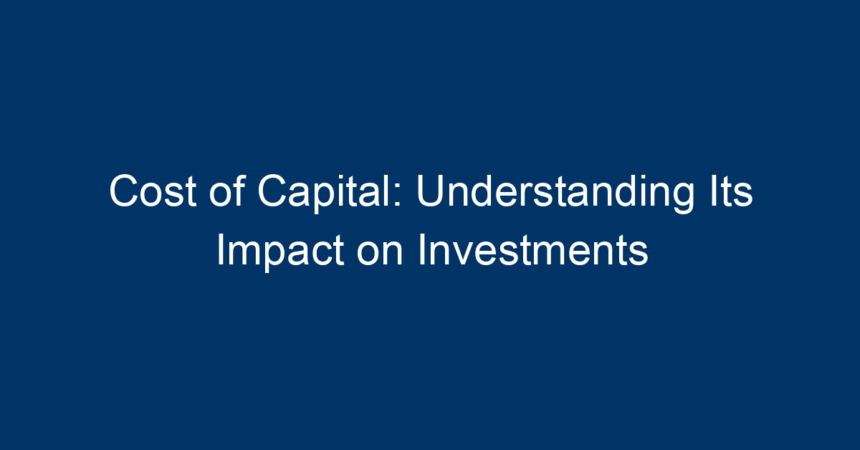In the realm of finance and investing, understanding the cost of capital is essential for making informed decisions. This critical concept not only influences how businesses evaluate projects but also shapes investor expectations. Whether you’re a seasoned investor or a newcomer to the financial world, grasping the intricacies of the cost of capital can significantly enhance your investment strategies.
What is Cost of Capital?
The cost of capital refers to the return that a company must earn on its investment to maintain its market value and attract funds. This benchmark is crucial for determining whether a project or investment will generate value. Essentially, the cost of capital serves as a hurdle rate; only projects that can achieve a return greater than this rate will be considered worthwhile.
Components of Cost of Capital
The cost of capital is typically comprised of several components:
-
Cost of Debt: This is the effective rate that a company pays on its borrowed funds. It is influenced by the interest rates and the risk profile of the company. Generally, the cost of debt is tax-deductible, making it an attractive option for businesses.
-
Cost of Equity: Unlike debt, the cost of equity is not easy to calculate. It represents the returns required by equity investors and can be estimated using models such as the Capital Asset Pricing Model (CAPM). This model factors in the risk-free rate, the equity risk premium, and the company’s beta.
- Weighted Average Cost of Capital (WACC): WACC combines the cost of both equity and debt, weighted by their respective proportions in the company’s capital structure. It’s a crucial metric for companies when evaluating new investments and projects.
The Importance of Cost of Capital in Investment Decisions
Understanding the cost of capital is vital for both businesses and investors. Let’s break down its significance.
1. Project Evaluation
Companies use the cost of capital as a baseline for evaluating potential projects. If the expected return on a project is greater than the cost of capital, it creates value for shareholders. Conversely, projects yielding lower returns could detract from value, leading to poor investment choices.
2. Financing Decisions
Businesses must decide on the most cost-effective ways to finance their operations and growth. Whether to issue equity, take on debt, or utilize internal funds will depend on their cost of capital. A lower cost of capital generally suggests that a company can afford to pursue risky ventures that could lead to substantial growth.
3. Risk Assessment
The cost of capital inherently embodies the risk associated with an investment. Higher risk generally translates to a higher cost of capital. Investors scrutinizing projects or companies will pay close attention to their cost of capital to understand the risk-return profile.
Factors Influencing Cost of Capital
Several variables can affect a company’s cost of capital:
-
Market Conditions: Economic factors such as interest rates, inflation, and market volatility can lead to changes in the cost of capital. For example, rising interest rates will increase the cost of debt.
-
Company’s Financial Health: A company’s credit rating plays a significant role. Firms with strong credit ratings typically enjoy lower borrowing costs, reducing their overall cost of capital.
- Business Risk: The intrinsic risk associated with a company’s industry and business model also affects the cost of equity. Companies operating in more volatility-prone sectors face higher costs of capital.
How Investors Utilize the Cost of Capital
Investors can leverage the concept of cost of capital in various ways:
1. Valuation
For equity valuation, the cost of capital becomes central to discounted cash flow (DCF) analyses. It acts as the discount rate to calculate the present value of future cash flows, thereby influencing investment valuations.
2. Portfolio Management
Understanding the cost of capital helps investors gauge the risk-return profiles of their portfolios. By analyzing the cost of capital associated with different investments, they can make more informed asset allocation decisions.
3. Performance Benchmarking
Investors often compare a company’s return on equity to its cost of equity. If a company’s ROE exceeds its cost of equity, it indicates efficient capital use, making it a potentially attractive investment.
Strategies to Minimize Cost of Capital
Reducing the cost of capital can immensely benefit a company. Here are some effective strategies:
-
Optimize Capital Structure: Balancing the mix of debt and equity can lower WACC. Companies should typically aim for a structure that minimizes costs while also managing risk.
-
Strengthen Financial Health: Improving credit ratings through better cash flow management and reduced debt levels can help lower the cost of debt.
-
Explore Different Financing Options: Evaluating various capital sources, such as crowdfunding, venture capital, or public offerings, can lead to lower costs depending on market conditions.
- Enhance Returns on Investments: Focusing on projects that yield higher returns than the cost of capital not only elevates company value but also reduces the perceived risk over time.
Common Misconceptions about Cost of Capital
Despite its significance, the cost of capital is often misunderstood. Here are some common myths debunked:
-
It’s Only Relevant for Big Corporations: Small businesses also need to understand their cost of capital to make informed financing and investment decisions.
-
High Cost Equals Bad Investment: Not necessarily. A higher cost of capital could justify higher returns in riskier ventures—an essential consideration for venture capitalists and private equity investors.
- Stable Across Industries: Different sectors have varying capital needs and risk profiles. Therefore, a company’s cost of capital is often unique to its industry.
Conclusion: Actionable Insights on Cost of Capital
Understanding the cost of capital is not merely an academic exercise; it has real-world implications for investment and corporate finance. By comprehending its components and significance, businesses and investors can make more informed decisions, assess risks accurately, and strategize effectively.
As an investor or decision-maker, incorporate these actionable insights:
- Always evaluate projects against their cost of capital.
- Use WACC as a key metric in financial analysis.
- Keep abreast of market conditions affecting interest rates and economic indicators.
- Strengthen your understanding of company-specific risks that may influence the cost of equity.
By mastering the dimensions of the cost of capital, you’ll be better positioned to navigate the complexities of investment and achieve sustained financial success.




